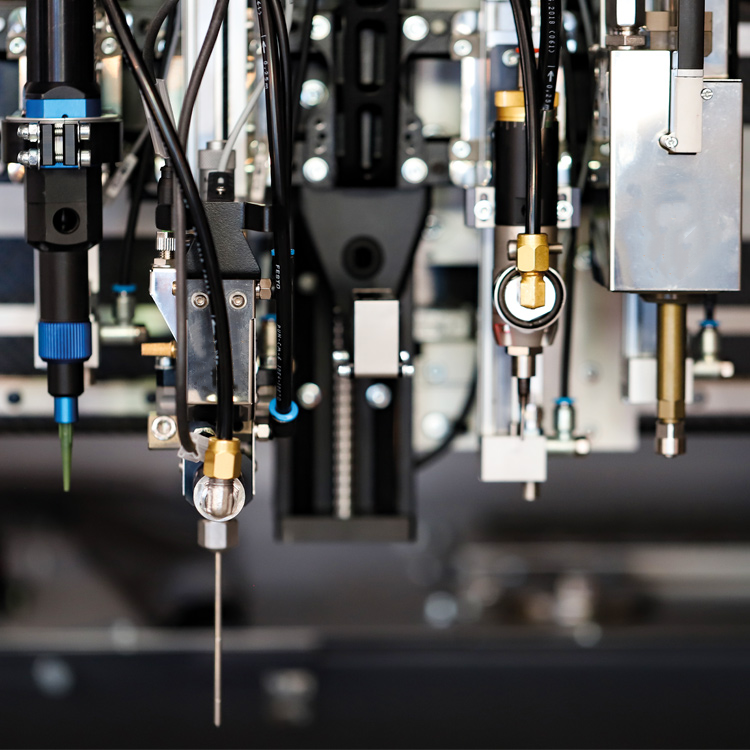Various technical process parameters that affect the quality of dispensing
Release time:2024-01-24Publisher:Jeenoce
The process defects that are prone to occur during product dispensing include: substandard glue dot size, drawing, glue immersion dyeing, poor curing strength, and easy detachment. To solve these problems, a comprehensive study of various technical process parameters should be conducted to find solutions.
1. The size of the dispensing amount
Based on work experience, the diameter of the adhesive point should be half of the product spacing. This ensures that there is sufficient glue to bond the components while avoiding excessive glue. The amount of glue applied is determined by the length of time, and in practice, the glue application time should be selected based on the production situation (room temperature, adhesive viscosity, etc.).
2. Dispensing pressure
The dispensing equipment provides a certain pressure to the needle (glue gun) to ensure the supply of glue, and the magnitude of the pressure determines the amount of glue supplied and the speed of glue flow out. Excessive pressure can easily cause glue overflow and excessive amount of glue; If the pressure is too low, intermittent dispensing and leakage may occur, leading to product defects. The pressure should be selected based on the properties of the adhesive and the working environment temperature. A high ambient temperature will reduce the viscosity and improve the fluidity of the adhesive. In this case, the pressure value needs to be lowered, and vice versa.
3. Needle size
In practical work, the inner diameter of the needle should be about half of the diameter of the dispensing point. During the dispensing process, the dispensing needle should be selected based on the size of the product. Products with significant differences in size should choose different needles to ensure the quality of adhesive points and improve production efficiency.

4. The distance between the needle and the working surface
Different dispensing machines use different needles, some of which have a certain degree of stopping. Before starting each work, the distance between the needle and the working surface should be calibrated, that is, the Z-axis height should be calibrated.
5. The viscosity of glue
The viscosity of glue directly affects the quality of dispensing. If the viscosity is high, the adhesive point will decrease, and even wire drawing may occur; When the viscosity is low, the adhesive point will increase, which may lead to infiltration of the product. During the dispensing process, choose a reasonable pressure and dispensing speed for adhesives with different viscosities.
6. Glue temperature
Generally, epoxy resin adhesive should be stored in a refrigerator at 0-5 ℃, and taken out half an hour in advance to ensure that the adhesive temperature is consistent with the working environment. The usage temperature of glue should be between 23 ℃ and 25 ℃; The ambient temperature has a significant impact on the viscosity of the adhesive. As the temperature decreases, the viscosity increases, and the adhesive flow rate correspondingly decreases, making it more prone to wire drawing. When other conditions are the same, a temperature difference of 5 ℃ in the environment can cause a 50% change in the amount of adhesive produced. Therefore, the environmental temperature should be controlled. At the same time, the temperature of the environment should also be guaranteed. If the temperature is too high, the adhesive point can easily dry and affect the bonding strength.
7. Curing temperature curve
For the curing of adhesive, the general manufacturer has provided a temperature curve. In practice, higher temperatures should be used as much as possible for curing, so that the adhesive has sufficient strength after curing.
8. Bubbles
Glue must not have bubbles. A small bubble can cause many products to lack glue; Every time the rubber hose is replaced midway, the air at the connection should be emptied to prevent empty tapping.
9. Fluid that requires special settings
Instant glue: For water-based instant glue, use a safety piston and Teflon lined metal needle. For thick instant glue, use a conical oblique needle. If flexibility is required, use a PP needle;
UV glue: Use an amber syringe, white piston, and angled needle (which can block ultraviolet rays). If using other types of needles, please customize a needle that can block ultraviolet rays;
UV curable adhesive: Use a black opaque syringe to avoid photosensitivity;
Anaerobic adhesive: Use a 10CC syringe and a white PE universal piston;
Sealant and paste like fluid: If the white piston rebounds severely, please switch to a safety type active type and use an angled needle.
For the adjustment of various parameters, it should be done from point to surface. Any change in one parameter will affect other aspects, and the occurrence of defects may be caused by multiple factors. Possible factors should be checked item by item.

